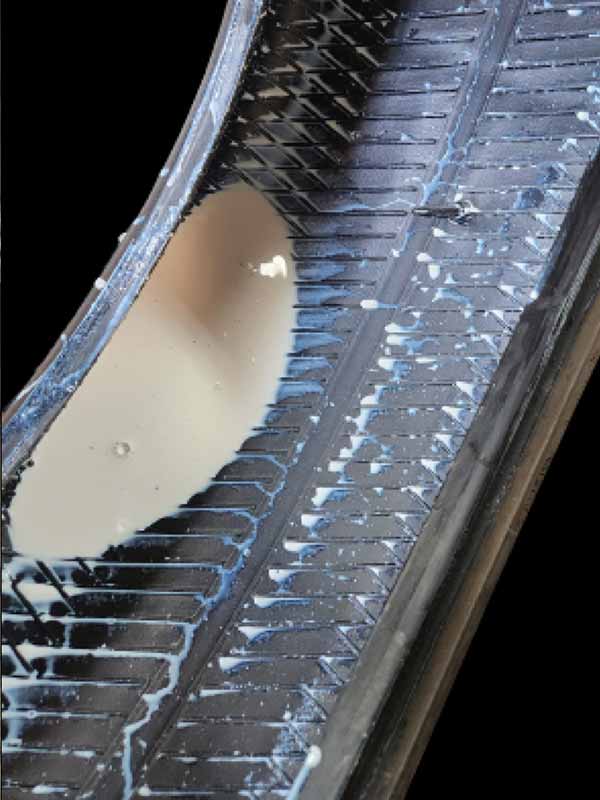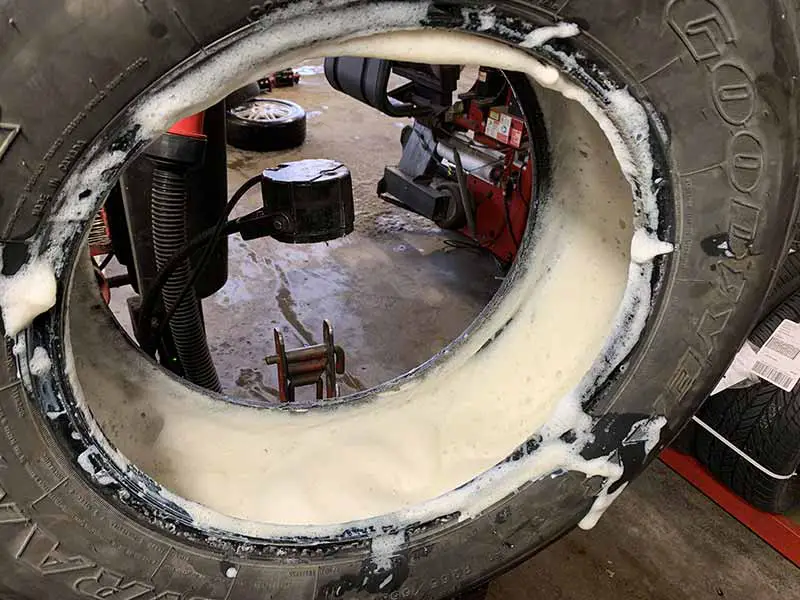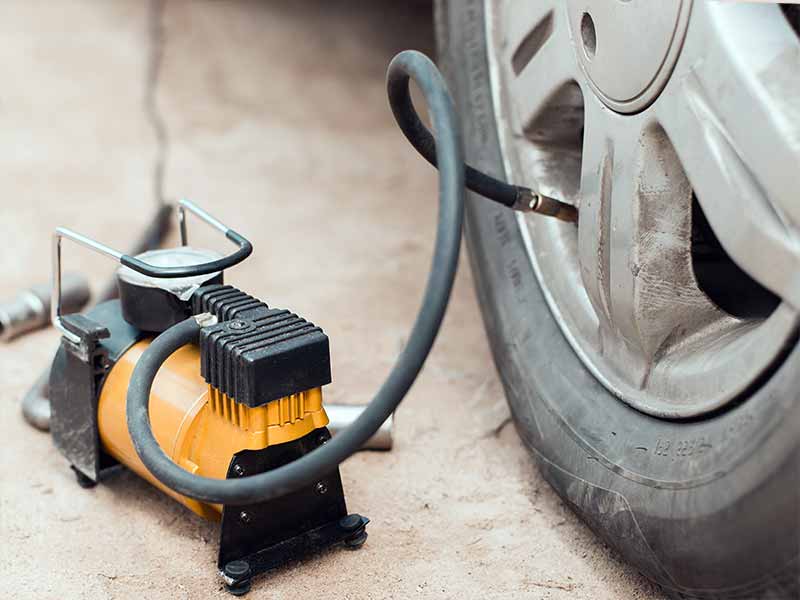If you’ve ever found yourself stranded with a flat tire, you know how frustrating it can be. Tire sealants can be a real lifesaver, but there is a lot of confusion about how they work and how to add air to tires when using them.
Can I Put Air In My Tires After Using Fix-A-Flat?
After using Fix-A-Flat to temporarily seal a puncture and inflate a tire, you can add more air if the tire pressure is still too low.
However, it’s important to check the tire pressure after driving a short distance (2-4 miles) to allow the sealant to distribute evenly and then adjust the air pressure accordingly.
In this article, we’ll help you navigate the ins and outs of using Fix-A-Flat and getting back on the road safely.
Let’s take a closer look.

Fix-A-Flat Aerosol Emergency Flat Tire Repair and Inflator
How Does A Can Of Fix-A-Flat Work?
Fix-A-Flat is a handy product that helps you fix flat tires in a pinch. It comes in a can that’s easy to use, even for those who aren’t experts on cars and trucks. So, how does this little miracle worker in a can actually do its job? Let’s break it down!
Inside the can, there’s a mix of a liquid sealant and compressed air. The sealant is a special goopy substance that can fill in small holes or punctures in your tire. When you have a flat, it’s usually because there’s a hole or tear that’s letting air escape. The sealant in Fix-A-Flat is designed to plug up these holes so the air can’t get out.
To use Fix-A-Flat, you first need to attach the hose on the can to the valve stem on your tire. This is the same place where you’d normally put air in. Once the hose is connected, you’ll press down on the nozzle, and the contents of the can will flow into the tire. As the sealant and compressed air move through the tire, the sealant finds the hole and fills it up. The compressed air helps to inflate the tire a bit, so it’s not completely flat anymore.
After the can is empty, you’ll need to drive your vehicle a short distance, like a mile or so. This helps to spread the sealant around the inside of the tire, making sure the hole is completely sealed. Once that’s done, your tire should be good to go, at least for a little while.
Keep in mind that Fix-A-Flat is meant to be a temporary solution. It’s great for emergencies, but you’ll still want to get your tire checked out by a professional as soon as you can. They’ll be able to tell you if it can be repaired or if it needs to be replaced.

Does Fix-A-Flat Put Air Into Your Tires?
You bet it does! Fix-A-Flat is designed to help you out when you’re stuck with a flat tire, and part of that process includes adding some air to your tire. But let’s dive a bit deeper into how that works.
As we mentioned earlier, a can of Fix-A-Flat contains both a liquid sealant and compressed air. When you’re using the product, you’re not just adding the sealant to your tire; you’re also putting in some extra air to inflate it a bit. While it won’t give you a fully inflated tire like you’d get at a gas station air pump, it will provide enough air to get you back on the road and to a safer location where you can address the issue further.
The compressed air in the can is designed to work together with the sealant, pushing it through the tire and helping it find and seal the hole. So, in a way, the air in the Fix-A-Flat can is doing double duty: inflating your tire a bit and helping the sealant do its job.
How Much PSI Is In A Can Of Fix-A-Flat?
PSI, or pounds per square inch, is a measure of the air pressure in your tires. When you’re inflating a tire, it’s important to know how much PSI you need to add to get it to the right level. So, how much PSI does a can of Fix-A-Flat offer?
Well, it’s not as straightforward as you might think. Fix-A-Flat doesn’t provide a specific PSI amount in each can because the amount of air pressure you’ll get depends on a few factors, like the size of your tire and how flat it is when you start.
Typically, a standard can of Fix-A-Flat (16 oz) can provide enough compressed air to inflate a completely flat tire to about 30 PSI, give or take a bit. That’s enough to get you back on the road and to a service station where you can properly inflate your tire. But remember, tire sealants like Fix-A-Flat are a temporary solution, and it won’t give you the perfect PSI for your tire.
Once you’ve used Fix-A-Flat and driven a short distance to spread the sealant, it’s a good idea to check your tire pressure with a gauge. If it’s still low, you can add more air at a service station or with a portable air compressor to get it up to the recommended PSI for your vehicle. You can usually find the correct PSI for your tires listed in your car’s owner’s manual or on a sticker inside the driver’s side door. And don’t forget to have a professional check your tire to see if it can be repaired or if it needs to be replaced.

Are You Supposed To Use The Whole Can Of Fix-A-Flat?
It’s generally best to use the whole can of Fix-A-Flat when you’re trying to fix flat tires.
The reason for this is that the can contains both the liquid sealant and compressed air, which work together to plug the hole in your tire and give it a bit of inflation. When you start using the can, it’s hard to know exactly how much sealant you’ve put into the tire and how much air has been added. Using the entire can ensures that you’re giving the sealant the best chance to do its job and providing your tire with enough air to get you back on the road safely.
If you only use part of the can, you might not get enough sealant or air into the tire, which could leave you with a tire that’s still too flat to drive on.
How Many Cans Of Fix-A-Flat Do I Need For A Tire?
In most cases, one can should be enough to fix a single flat tire. A standard 16 oz can of Fix-A-Flat is designed to work with most passenger cars and trucks, and it typically contains enough sealant and compressed air to plug a small hole and inflate the tire enough to get you back on the road. So, for most situations, one can should be all you need.
That said, there are some exceptions to this rule. If you’re dealing with a larger tire, like those found on some trucks or SUVs, you might need more than one can to fully seal the hole and add enough air pressure. In this case, it’s a good idea to have a second can on hand, just in case. But for the majority of vehicles, one can should do the trick.
What Happens If You Use Too Much Fix-A-Flat?
If you use too much Fix-A-Flat, you might end up with an overinflated tire. This can cause your tire to bulge and increase the risk of a blowout or uneven wear on the tire tread. To avoid this, it’s important to check your tire pressure after using it and release some air if the pressure is too high. You can find the recommended tire pressure for your vehicle in the owner’s manual or on a sticker inside the driver’s side door.
Another potential issue with using too much Fix-A-Flat is that the excess sealant inside the tire can cause an imbalance. When your tires aren’t properly balanced, it can lead to uneven wear, poor handling, and a rougher ride. If you suspect that you’ve used too much tire sealant and your tire feels out of balance, it’s a good idea to visit a tire shop or mechanic to have the tire checked out and balanced.

How Long Can You Drive On A Tire With Fix-A-Flat?
The important thing to remember is that tire sealants are designed to be a temporary fix, meant to get you back on the road and to a service station or repair shop where your tire can be properly inspected.
In general, you should only drive on a tire treated with Fix-A-Flat for about 50 to 100 miles or until you can get to a professional to have the tire looked at. This distance should be enough to get you to a nearby repair shop without putting too much strain on the tire.
Keep in mind that you should avoid driving at high speeds or for long distances with a tire treated with tire sealants, as it could lead to further damage or even a blowout.
Resources
Below are some links you may find helpful when learning about tires
Final Thoughts
In the end, tire sealants can be a real lifesaver when you find yourself stuck with a flat tire. Remember the key points we talked about in this article – how Fix-A-Flat works, when to add air, and how long you can drive on a treated tire. These tips will help you stay safe and get back on the road quickly.
Keep in mind that Fix-A-Flat is a temporary solution, and it’s important to visit a professional to repair or replace your tire as soon as possible. As the famous saying goes, “An ounce of prevention is worth a pound of cure.” So, take care of your tires, and they’ll take care of you.
Good luck and happy motoring.





